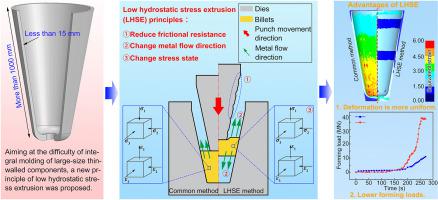当前位置:
X-MOL 学术
›
Int. J. Mach. Tool Manu.
›
论文详情
Our official English website, www.x-mol.net, welcomes your feedback! (Note: you will need to create a separate account there.)
Investigation on low hydrostatic stress extrusion technology for forming of large thin-walled components with high ribs
International Journal of Machine Tools and Manufacture ( IF 14.0 ) Pub Date : 2024-03-25 , DOI: 10.1016/j.ijmachtools.2024.104149 Zhimin Zhang , Zhe Chen , Yong Xue , Xing Zhang , Qiang Wang
International Journal of Machine Tools and Manufacture ( IF 14.0 ) Pub Date : 2024-03-25 , DOI: 10.1016/j.ijmachtools.2024.104149 Zhimin Zhang , Zhe Chen , Yong Xue , Xing Zhang , Qiang Wang

|
An increase in hydrostatic stress improves the plasticity of metallic materials. However, for some special components, such as large thin-walled components with high ribs, excessive hydrostatic stress can cause several problems that make it impossible to prepare such components using plastic forming methods. In this study, the effect of hydrostatic stress on the deformation behavior of large thin-walled components with high ribs was investigated using a combination of numerical simulations and theoretical derivations. The results indicated that excessive hydrostatic stress leads to die failure, causing metal flow difficulties, uneven deformation, inconsistent mechanical properties, and reduced forming accuracy. Therefore, a low-hydrostatic-stress extrusion method was proposed by adjusting the contact friction, metal flow direction and displacement, and force boundary conditions to reduce the hydrostatic compressive stress. These principles are mainly reflected in the following three aspects: First, the size of the difficult deformation zone was reduced by changing the friction conditions from dry friction to fluid friction or boundary friction to reduce the frictional resistance. Second, the high-stress zone was eliminated by changing the metal flow direction, adjusting the strain state from unidirectional to multi-directional flow, shortening the metal flow path, and reducing the metal flow resistance. Third, the strong compressive stress state in the three directions was weakened by regulating the force boundary conditions and changing the loading method from one-way extrusion to multi-directional loading. Based on these principles, a series of new forming technologies have been developed, such as actively counteracting frictional resistance, slotting, and ditching on dies for long-lasting lubrication, multi-directional short-range metal flow, drawing-assisted extrusion, and multi-directional active loading. The adoption of these technologies realizes the labor-efficient formation of large thin-walled components with high ribs and provides the formed members with high precision and uniform mechanical properties.
中文翻译:

大型高筋薄壁构件低静水应力挤压成形技术研究
静水应力的增加提高了金属材料的塑性。然而,对于一些特殊部件,例如具有高肋的大型薄壁部件,过度的静水应力可能会导致一些问题,导致无法使用塑性成型方法制备此类部件。在本研究中,结合数值模拟和理论推导研究了静水应力对大型高肋薄壁部件变形行为的影响。结果表明,过大的静水应力会导致模具失效,导致金属流动困难、变形不均匀、机械性能不一致、成形精度降低。因此,提出了一种低静水应力挤压方法,通过调整接触摩擦、金属流动方向和位移以及力边界条件来降低静水压应力。这些原理主要体现在以下三个方面:一是通过将摩擦条件由干摩擦改为流体摩擦或边界摩擦,减小难变形区的尺寸,以降低摩擦阻力。其次,通过改变金属流动方向,将应变状态由单向流动调整为多向流动,缩短金属流动路径,降低金属流动阻力,消除高应力区。第三,通过调节力边界条件,将加载方式由单向挤压改为多向加载,削弱了三个方向的强压应力状态。基于这些原理,开发了一系列新的成形技术,如主动抵消摩擦阻力、模具上的开槽和开沟以实现持久润滑、多向短程金属流动、拉拔辅助挤压和多向成形等。 -定向主动加载。这些技术的采用,实现了大型高筋薄壁构件的高效成形,并为成形件提供了高精度和均匀的机械性能。
更新日期:2024-03-25
中文翻译:

大型高筋薄壁构件低静水应力挤压成形技术研究
静水应力的增加提高了金属材料的塑性。然而,对于一些特殊部件,例如具有高肋的大型薄壁部件,过度的静水应力可能会导致一些问题,导致无法使用塑性成型方法制备此类部件。在本研究中,结合数值模拟和理论推导研究了静水应力对大型高肋薄壁部件变形行为的影响。结果表明,过大的静水应力会导致模具失效,导致金属流动困难、变形不均匀、机械性能不一致、成形精度降低。因此,提出了一种低静水应力挤压方法,通过调整接触摩擦、金属流动方向和位移以及力边界条件来降低静水压应力。这些原理主要体现在以下三个方面:一是通过将摩擦条件由干摩擦改为流体摩擦或边界摩擦,减小难变形区的尺寸,以降低摩擦阻力。其次,通过改变金属流动方向,将应变状态由单向流动调整为多向流动,缩短金属流动路径,降低金属流动阻力,消除高应力区。第三,通过调节力边界条件,将加载方式由单向挤压改为多向加载,削弱了三个方向的强压应力状态。基于这些原理,开发了一系列新的成形技术,如主动抵消摩擦阻力、模具上的开槽和开沟以实现持久润滑、多向短程金属流动、拉拔辅助挤压和多向成形等。 -定向主动加载。这些技术的采用,实现了大型高筋薄壁构件的高效成形,并为成形件提供了高精度和均匀的机械性能。












































 京公网安备 11010802027423号
京公网安备 11010802027423号